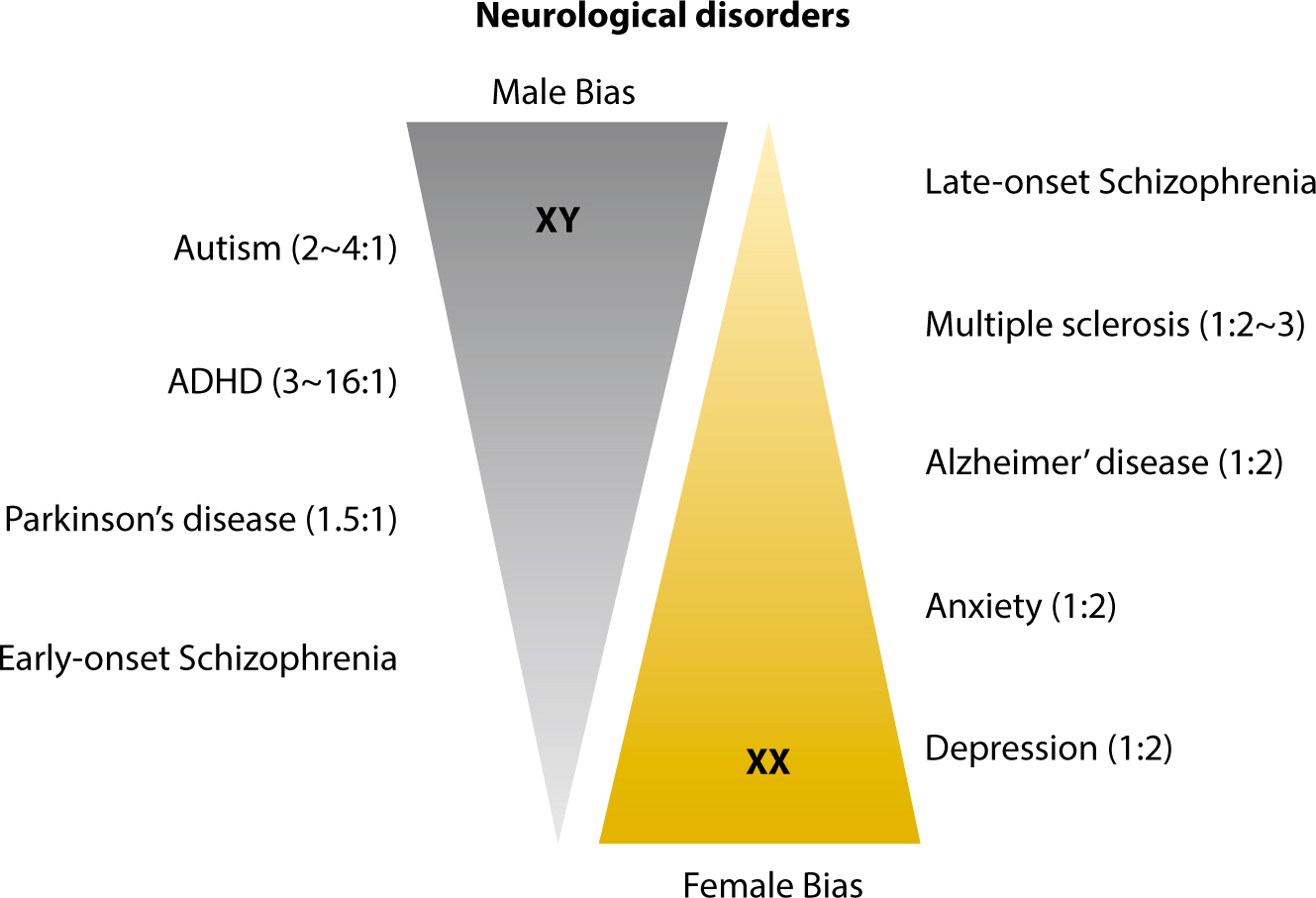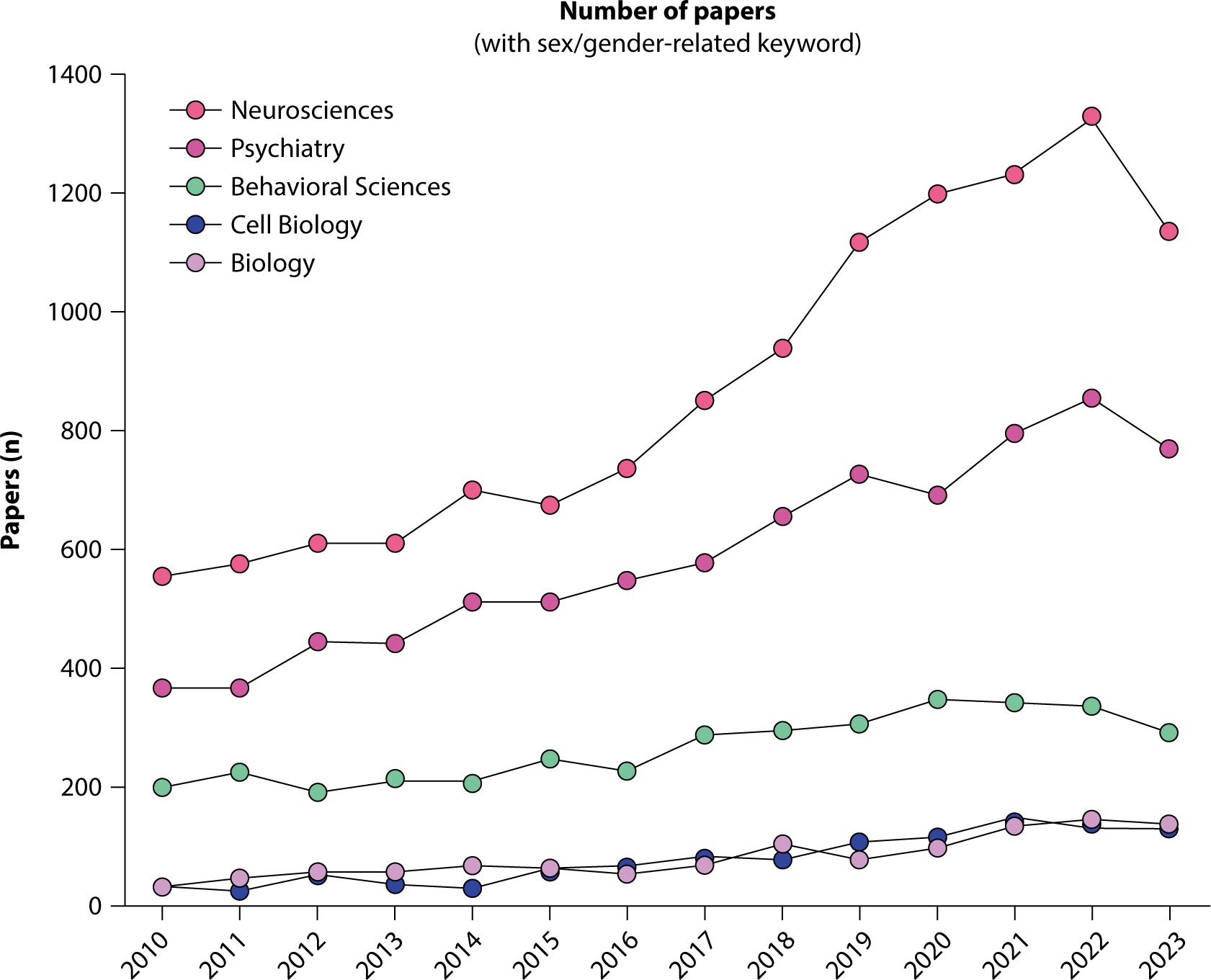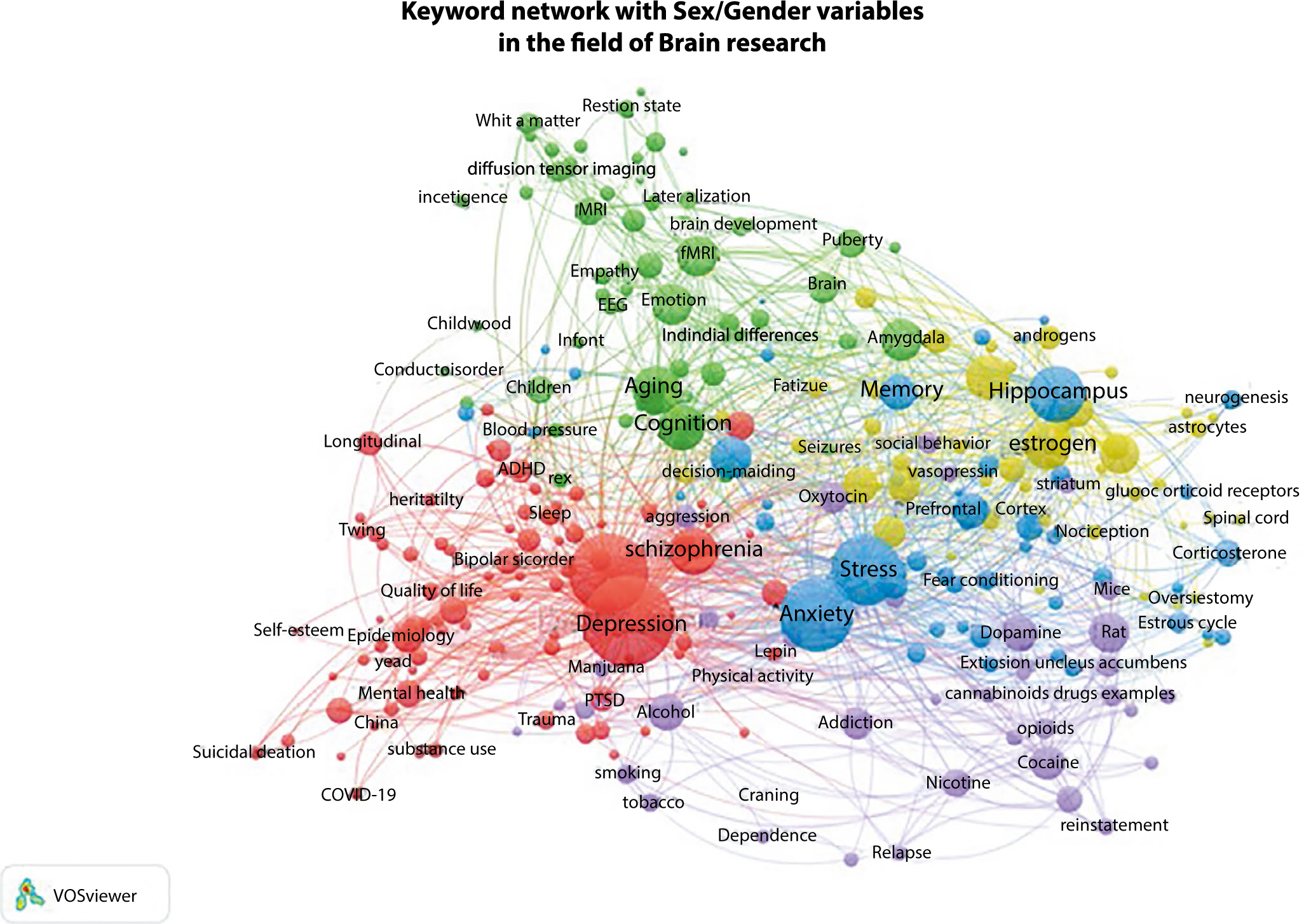Ewha Med J.
2024 Apr;47(2):e16. 10.12771/emj.2024.e16.
Current status and significance of research on sex differences in neuroscience: a narrative review and bibliometric analysis
- Affiliations
-
- 1Policy Research Team, Korea Center for Gendered Innovations for Science and Technology Research (GISTeR), Seoul, Korea
- 2Korea Center for Gendered Innovations for Science and Technology Research (GISTeR), Seoul, Korea
- 3Ewha Womans University, Seoul, Korea
- KMID: 2556305
- DOI: http://doi.org/10.12771/emj.2024.e16
Abstract
- This review aims to highlight the importance of research on structural, functional, molecular-biological, and disease-specific sex differences in the brain, and to examine current bibliometric indicators related to research on sex differences. The Web of Science Core Collection was searched for related articles from 2010 to 2023. Structural and functional brain differences according to sex, including variations in communication patterns between hemispheres, may play a role in mental disorders. Sex differences in neurotransmitters such as serotonin, dopamine, and γ-aminobutyric acid contribute to disparities in mental health, addiction, and neurodevelopmental conditions. Neurodevelopmental disorders such as autism spectrum disorder and schizophrenia exhibit sex-based differences in prevalence, symptoms, brain changes, and neurotransmitter disruptions under hormonal influence. There is a growing body of research on depression, adolescence, the hippocampus, the amygdala, and cognition, highlighting the importance of considering sex/gender factors. Recent studies on sex differences in brain diseases have identified variations in brain structure, function, and neurophysiological substances, as well as in hormones and genes between the sexes. The incidence of psychiatric disorders such as autism spectrum disorder, depression, anxiety, and Alzheimer's disease is increasingly being linked to sex differences, and the need for research into the mechanisms underlying these differences is gaining recognition. However, there remains a significant gap in sex-specific neuroscience research related to the diagnosis, treatment, prevention, and management of these conditions. Advancing inclusive research will require comprehensive training, a consensus on methodology, diverse perspectives through collaborative frameworks, governmental/institutional support, and dedicated funding to create suitable research environments and implementation strategies.
Keyword
Figure
Reference
-
References
1. GBD 2019 Mental Disorders Collaborators. Global, regional, and national burden of 12 mental disorders in 204 countries and territories, 1990–2019: a systematic analysis for the Global Burden of Disease Study 2019. Lancet Psychiatry. 2022; 9(2):137–150. DOI: 10.1016/S2215-0366(21)00395-3. PMID: 35026139.2. Babinski DE. Sex differences in ADHD: review and priorities for future research. Curr Psychiatry Rep. 2024; 26(4):151–156. DOI: 10.1007/s11920-024-01492-6. PMID: 38324203.3. Bangasser DA, Cuarenta A. Sex differences in anxiety and depression: circuits and mechanisms. Nat Rev Neurosci. 2021; 22(11):674–684. DOI: 10.1038/s41583-021-00513-0. PMID: 34545241.4. Bianco A, Antonacci Y, Liguori M. Sex and gender differences in neurodegenerative diseases: challenges for therapeutic opportunities. Int J Mol Sci. 2023; 24(7):6354. DOI: 10.3390/ijms24076354. PMID: 37047320. PMCID: PMC10093984.5. Calderoni S. Sex/gender differences in children with autism spectrum disorder: a brief overview on epidemiology, symptom profile, and neuroanatomy. J Neurosci Res. 2023; 101(5):739–750. DOI: 10.1002/jnr.25000. PMID: 35043482.6. Fernández-Artamendi S, Martínez-Loredo V, López-Núñez C. Sex differences in comorbidity between substance use and mental health in adolescents: two sides of the same coin. Psicothema. 2021; 33(1):36–43.7. Ferri SL, Abel T, Brodkin ES. Sex differences in autism spectrum disorder: a review. Curr Psychiatry Rep. 2018; 20(2):1–17. DOI: 10.1007/s11920-018-0874-2. PMID: 29504047. PMCID: PMC6477922.8. Napolitano A, Schiavi S, La Rosa P, Rossi-Espagnet MC, Petrillo S, Bottino F, et al. Sex differences in autism spectrum disorder: diagnostic, neurobiological, and behavioral features. Front Psychiatry. 2022; 13:889636. DOI: 10.3389/fpsyt.2022.889636. PMID: 35633791. PMCID: PMC9136002.9. Ferretti MT, Florencia Iulita M, Cavedo E, Andrea Chiesa P, Schumacher Dimech A, Santuccione Chadha A, et al. Sex differences in Alzheimer disease: the gateway to precision medicine. Nat Rev Neurol. 2018; 14(8):457–469. DOI: 10.1038/s41582-018-0032-9. PMID: 29985474.10. Pinares-Garcia P, Stratikopoulos M, Zagato A, Loke H, Lee J. Sex: a significant risk factor for neurodevelopmental and neurodegenerative disorders. Brain Sci. 2018; 8(8):154. DOI: 10.3390/brainsci8080154. PMID: 30104506. PMCID: PMC6120011.11. Zhu D, Montagne A, Zhao Z. Alzheimer's pathogenic mechanisms and underlying sex difference. Cell Mol Life Sci. 2021; 78(11):4907–4920. DOI: 10.1007/s00018-021-03830-w. PMID: 33844047. PMCID: PMC8720296.12. Cerri S, Mus L, Blandini F. Parkinson's disease in women and men: what's the difference? J Parkinson’s Dis. 2019; 9(3):501–515. DOI: 10.3233/JPD-191683. PMID: 31282427. PMCID: PMC6700650.13. Oltra J, Segura B, Strafella AP, van Eimeren T, Ibarretxe-Bilbao N, Diez-Cirarda M, et al. A multi-site study on sex differences in cortical thickness in non-demented Parkinson’s disease. npj Parkinson's Dis. 2024; 10(1):69. DOI: 10.1038/s41531-024-00686-2. PMID: 38521776. PMCID: PMC10960793.14. Oltra J, Uribe C, Campabadal A, Inguanzo A, Monté-Rubio GC, Martí MJ, et al. Sex differences in brain and cognition in de novo Parkinson's disease. Front Aging Neurosci. 2021; 13:791532. DOI: 10.3389/fnagi.2021.791532. PMID: 35069180. PMCID: PMC8770804.15. Health Canada. Health portfolio: sex- and gender-based analysis plus policy: advancing equity, diversity and inclusion [Internet]. Ottawa (ON): CIHR;c2022. [cited 2024 Jan 21]. Available from: https://www.canada.ca/en/health-canada/corporate/transparency/corporate-management-reporting/heath-portfolio-sex-gender-based-analysis-policy.html.16. Arnegard ME, Whitten LA, Hunter C, Clayton JA. Sex as a biological variable: a 5-year progress report and call to action. J Womens Health. 2020; 29(6):858–864. DOI: 10.1089/jwh.2019.8247. PMID: 31971851. PMCID: PMC7476377.17. Clayton JA, Collins FS. Policy: NIH to balance sex in cell and animal studies. Nature. 2014; 509(7500):282–283. DOI: 10.1038/509282a. PMID: 24834516. PMCID: PMC5101948.18. Cosgrove KP, Mazure CM, Staley JK. Evolving knowledge of sex differences in brain structure, function, and chemistry. Biol Psychiatry. 2007; 62(8):847–855. DOI: 10.1016/j.biopsych.2007.03.001. PMID: 17544382. PMCID: PMC2711771.19. McCarthy MM, Pickett LA, VanRyzin JW, Kight KE. Surprising origins of sex differences in the brain. Horm Behav. 2015; 76:3–10. DOI: 10.1016/j.yhbeh.2015.04.013. PMID: 25917865. PMCID: PMC4620061.20. van Eijk L, Zhu D, Couvy-Duchesne B, Strike LT, Lee AJ, Hansell NK, et al. Are sex differences in human brain structure associated with sex differences in behavior? Psychol Sci. 2021; 32(8):1183–1197. DOI: 10.1177/0956797621996664. PMID: 34323639. PMCID: PMC8726594.21. Rechlin RK, Splinter TFL, Hodges TE, Albert AY, Galea LAM. An analysis of neuroscience and psychiatry papers published from 2009 and 2019 outlines opportunities for increasing discovery of sex differences. Nat Commun. 2022; 13(1):2137. DOI: 10.1038/s41467-022-29903-3. PMID: 35440664. PMCID: PMC9018784.22. Ruigrok ANV, Salimi-Khorshidi G, Lai MC, Baron-Cohen S, Lombardo MV, Tait RJ, et al. A meta-analysis of sex differences in human brain structure. Neurosci Biobehav Rev. 2014; 39(100):34–50. DOI: 10.1016/j.neubiorev.2013.12.004. PMID: 24374381. PMCID: PMC3969295.23. Ingalhalikar M, Smith A, Parker D, Satterthwaite TD, Elliott MA, Ruparel K, et al. Sex differences in the structural connectome of the human brain. Proc Natl Acad Sci USA. 2014; 111(2):823–828. DOI: 10.1073/pnas.1316909110. PMID: 24297904. PMCID: PMC3896179.24. Kaczkurkin AN, Raznahan A, Satterthwaite TD. Sex differences in the developing brain: insights from multimodal neuroimaging. Neuropsychopharmacology. 2019; 44(1):71–85. DOI: 10.1038/s41386-018-0111-z. PMID: 29930385. PMCID: PMC6235840.25. Jovanovic H, Lundberg J, Karlsson P, Cerin Å, Saijo T, Varrone A, et al. Sex differences in the serotonin 1A receptor and serotonin transporter binding in the human brain measured by PET. NeuroImage. 2008; 39(3):1408–1419. DOI: 10.1016/j.neuroimage.2007.10.016. PMID: 18036835.26. Nishizawa S, Benkelfat C, Young SN, Leyton M, Mzengeza S, de Montigny C, et al. Differences between males and females in rates of serotonin synthesis in human brain. Proc Natl Acad Sci USA. 1997; 94(10):5308–5313. DOI: 10.1073/pnas.94.10.5308. PMID: 9144233. PMCID: PMC24674.27. Rubinow DR, Schmidt PJ, Roca CA. Estrogen–serotonin interactions: implications for affective regulation. Biol Psychiatry. 1998; 44(9):839–850. DOI: 10.1016/S0006-3223(98)00162-0. PMID: 9807639.28. Moncrieff J, Cooper RE, Stockmann T, Amendola S, Hengartner MP, Horowitz MA. The serotonin theory of depression: a systematic umbrella review of the evidence. Mol Psychiatry. 2023; 28(8):3243–3256. DOI: 10.1038/s41380-022-01661-0. PMID: 35854107. PMCID: PMC10618090.29. Williams OOF, Coppolino M, George SR, Perreault ML. Sex differences in dopamine receptors and relevance to neuropsychiatric disorders. Brain Sci. 2021; 11(9):1199. DOI: 10.3390/brainsci11091199. PMID: 34573220. PMCID: PMC8469878.30. Zachry JE, Nolan SO, Brady LJ, Kelly SJ, Siciliano CA, Calipari ES. Sex differences in dopamine release regulation in the striatum. Neuropsychopharmacology. 2021; 46(3):491–499. DOI: 10.1038/s41386-020-00915-1. PMID: 33318634. PMCID: PMC8027008.31. Gabel F, Hovhannisyan V, Berkati AK, Andry V, Goumon Y. Sex differences in neurotransmitter levels in different brain regions after acute and chronic morphine treatment in mice [Internet]. Cold Spring Harbor (NY): Cold Spring Harbor Laboratory;c2023. [cited 2024 Jan 10]. Available from: https://www.biorxiv.org/content/10.1101/2023.01.16.524193v1.full.pdf. DOI: 10.1101/2023.01.16.524193.32. McCarthy MM, Auger AP, Perrot-Sinal TS. Getting excited about GABA and sex differences in the brain. Trends Neurosci. 2002; 25(6):307–312. DOI: 10.1016/S0166-2236(02)02182-3. PMID: 12086749.33. Mukherjee J, Cardarelli RA, Cantaut-Belarif Y, Deeb TZ, Srivastava DP, Tyagarajan SK, et al. Estradiol modulates the efficacy of synaptic inhibition by decreasing the dwell time of GABAA receptors at inhibitory synapses. Proc Natl Acad Sci USA. 2017; 114(44):11763–11768. DOI: 10.1073/pnas.1705075114. PMID: 29078280. PMCID: PMC5676881.34. Horder J, Petrinovic MM, Mendez MA, Bruns A, Takumi T, Spooren W, et al. Glutamate and GABA in autism spectrum disorder: a translational magnetic resonance spectroscopy study in man and rodent models. Transl Psychiatry. 2018; 8(1):106. DOI: 10.1038/s41398-018-0155-1. PMID: 29802263. PMCID: PMC5970172.35. Zhao H, Mao X, Zhu C, Zou X, Peng F, Yang W, et al. GABAergic system dysfunction in autism spectrum disorders. Front Cell Dev Biol. 2021; 9:781327. DOI: 10.3389/fcell.2021.781327. PMID: 35198562. PMCID: PMC8858939.36. Farkas I, Bálint F, Farkas E, Vastagh C, Fekete C, Liposits Z. Estradiol increases glutamate and GABA neurotransmission into GnRH neurons via retrograde no-signaling in proestrous mice during the positive estradiol feedback period. eNeuro. 2018; 5(4):ENEURO.0057-18.2018. DOI: 10.1523/ENEURO.0057-18.2018. PMID: 30079374. PMCID: PMC6073979.37. Mendrek A, Mancini-Marïe A. Sex/gender differences in the brain and cognition in schizophrenia. Neurosci Biobehav Rev. 2016; 67:57–78. DOI: 10.1016/j.neubiorev.2015.10.013. PMID: 26743859.38. Mohammadi S, Seyedmirzaei H, Amin Salehi M, Jahanshahi A, Sina Zakavi S, Dehghani Firouzabadi F, et al. Brain-based sex differences in depression: a systematic review of neuroimaging studies. Brain Imaging Behav. 2023; 17(5):541–569. DOI: 10.1007/s11682-023-00772-8. PMID: 37058182. PMCID: PMC10102695.39. Aldrete L, Moser MV, Putignano G, Ferretti MT, Schumacher Dimech A, Santuccione Chadha A. Sex and gender considerations in Alzheimer’s disease: the Women’s Brain Project contribution. Front Aging Neurosci. 2023; 15:1105620. DOI: 10.3389/fnagi.2023.1105620. PMID: 37065460. PMCID: PMC10097993.40. Kodama L, Gan L. Do microglial sex differences contribute to sex differences in neurodegenerative diseases? Trends Mol Med. 2019; 25(9):741–749. DOI: 10.1016/j.molmed.2019.05.001. PMID: 31171460. PMCID: PMC7338035.41. Accounting for sex and gender makes for better science. Nature. 2020; 588(7837):196. DOI: 10.1038/d41586-020-03459-y. PMID: 33299202.42. Nature journals raise the bar on sex and gender reporting in research. Nature. 2022; 605(7910):396. DOI: 10.1038/d41586-022-01218-9. PMID: 35585338.43. A broader vision for women's health. Lancet. 2023; 402(10399):347. DOI: 10.1016/S0140-6736(23)01570-2. PMID: 37516532.44. The gendered dimensions of COVID-19. Lancet. 2020; 395(10231):1168. DOI: 10.1016/S0140-6736(20)30823-0. PMID: 32278370.45. Sweet DJ. New at cell press: the inclusion and diversity statement. Cell. 2021; 184(1):1–2. DOI: 10.1016/j.cell.2020.12.019. PMID: 33417857.46. Guneykaya D, Ivanov A, Perez Hernandez D, Beule D, Kettenmann H, Wolf SA, et al. Transcriptional and translational differences of microglia from male and female brains. Cell Rep. 2018; 24(10):2773–2783.E6. DOI: 10.1016/j.celrep.2018.08.001. PMID: 30184509.47. Villa A, Gelosa P, Castiglioni L, Cimino M, Rizzi N, Pepe G, et al. Sex-specific features of microglia from adult mice. Cell Rep. 2018; 23(12):3501–3511. DOI: 10.1016/j.celrep.2018.05.048. PMID: 29924994. PMCID: PMC6024879.48. Prinz M, Jung S, Priller J. Microglia biology: one century of evolving concepts. Cell. 2019; 179(2):292–311. DOI: 10.1016/j.cell.2019.08.053. PMID: 31585077.49. Han J, Fan Y, Zhou K, Blomgren K, Harris RA. Uncovering sex differences of rodent microglia. J Neuroinflammation. 2021; 18(1):74. DOI: 10.1186/s12974-021-02124-z. PMID: 33731174. PMCID: PMC7972194.50. Lynch MA. Exploring sex-related differences in microglia may be a game-changer in precision medicine. Front Aging Neurosci. 2022; 14:868448. DOI: 10.3389/fnagi.2022.868448. PMID: 35431903. PMCID: PMC9009390.51. Schumacher Dimech A, Ferretti MT, Sandset EC, Santuccione Chadha A. The role of sex and gender differences in precision medicine: the work of the Women’s Brain Project. Eur Heart J. 2021; 42(34):3215–3217. DOI: 10.1093/eurheartj/ehab297. PMID: 34131709.
- Full Text Links
- Actions
-
Cited
- CITED
-
- Close
- Share
- Similar articles
-
- Sex differences in metabolic dysfunction-associated steatotic liver disease: a narrative review
- Considerations for Chronic Pain Management Based on Sex Differences: A Narrative Review
- An In-Depth Bibliometric Analysis and Current Perspective on Male infertility Research
- Publication trends of somatic mutation and recombination tests research: a bibliometric analysis (1984‒2020)
- Sex differences in coronary atherogenesis: a narrative review




